Decorating a bay window isn't just about dressing a set of windows; it’s about transforming an architectural feature into the heart of a room. It's about seeing those angles not as a puzzle, but as a canvas for creativity. Do you picture a cosy reading nook, a sun-drenched display for your plants, or even a compact home office?
Unlocking Your Bay Window's Potential
That beautiful bay window is so much more than a source of light—it's an architectural gift brimming with possibilities. Instead of getting bogged down by the unusual angles, the trick is to see it as a versatile alcove that can inject character, function, and a huge dose of charm into any space.
This unique area, which so many people find tricky to decorate, is actually a natural focal point just waiting to be shown off. Bay windows have a strong presence in the UK, popping up everywhere in the Victorian era. Today, we still love them, not just for their elegance and kerb appeal, but because they flood our homes with light and create wonderfully intimate nooks.
From Awkward Space to Main Attraction
I get it – that three-sided structure can feel a bit intimidating. But that’s precisely what makes it so special! The alcove it creates gives you a defined zone that can serve a purpose entirely different from the rest of the room. This little bit of separation means you can be more playful and adventurous with your design choices without overwhelming the main living area.
Think of it as a mini-room within a room. This mindset is a game-changer, especially in smaller homes where every square foot is precious. In fact, getting creative with a bay window can make a compact living room feel much larger and more dynamic. For more inspiration, have a look at some clever small living room layout ideas that really know how to make the most of these unique features.
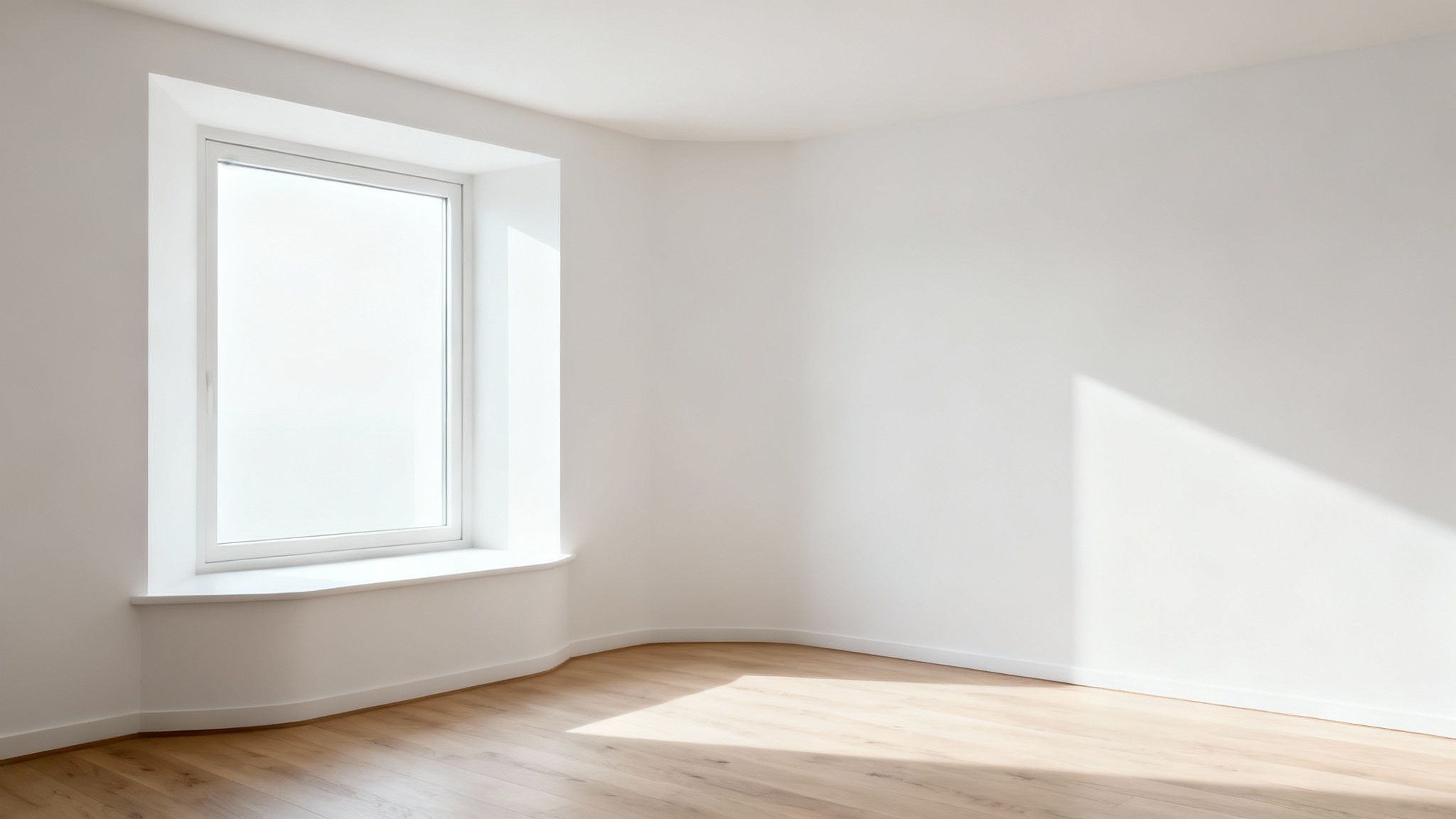
Defining Your Bay Window's Purpose
Before you even think about picking out fabrics or furniture, stop and ask yourself: what do I want this space to do? Your answer will guide every single decision you make from here on out.
- A Relaxation Zone: Imagine a cosy reading nook with a built-in bench, piled high with plush cushions and a soft throw. This simple setup can transform the area into your own peaceful retreat.
- A Green Sanctuary: All that natural light is a plant's dream. Why not turn the space into a 'plant bay'? Grouping together plants of different heights and textures creates a vibrant, living display that brings the outdoors in.
- A Functional Workspace: A slim desk and a comfortable chair can turn the alcove into a light-filled home office. It's perfect for those tasks that don't need a massive setup.
The most successful bay window designs I’ve seen are always the ones that blend seamlessly with the homeowner's lifestyle. It's not just about how it looks; it's about creating a space you will genuinely use and love every single day.
Choosing the Right Window Dressings
Finding the perfect treatment for a bay window can feel like a daunting task, but it’s honestly the most important decision you'll make when styling this unique space. The right dressing is a delicate balancing act between privacy, light control, and style. Get it right, and you'll turn your window into a true showpiece.
The choice you make will completely define the room's atmosphere. Are you after the soft, flowing fabric of curtains to create a cosy, inviting feel? Or do you prefer the clean, architectural lines of shutters for a more structured, modern look?
Let's break down the best options to help you figure out what's right for your home.
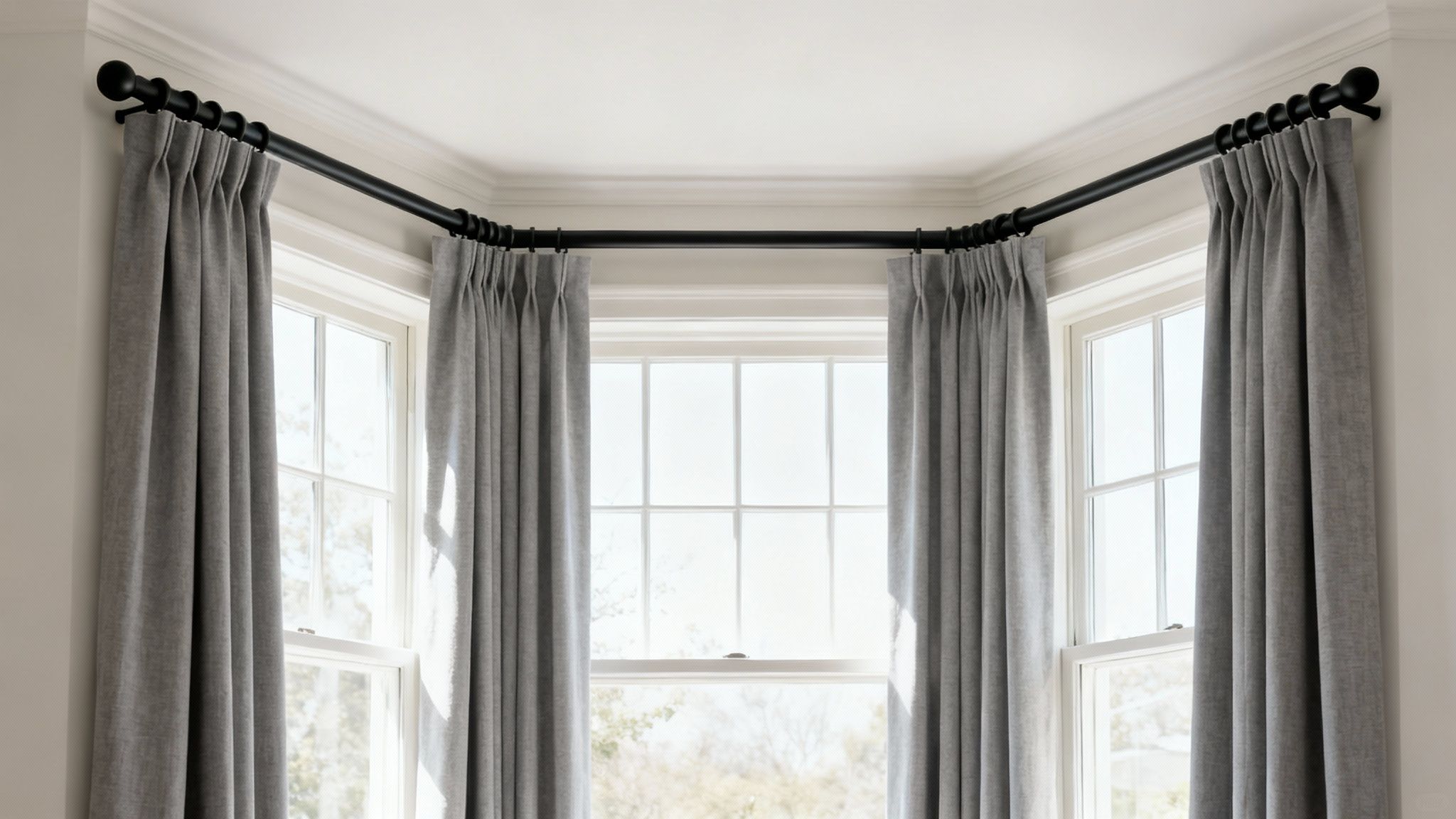
Curtains: A Classic and Versatile Choice
Curtains are a fantastic way to bring warmth, colour, and texture into a room. For a bay window, you have a couple of ways to hang them. A custom-bent curtain pole that follows the exact curve of the bay is a brilliant solution, allowing a single pair of curtains to glide seamlessly across the entire space. This creates a really cohesive, flowing look that feels incredibly elegant.
Your other option is to use individual straight poles for each section of the window. This creates a more defined, panelled effect, which can work beautifully if you want to frame each window distinctly. To get a better handle on fabrics and heading styles, our curtain buying guide offers some great insights.
Blinds for a Tailored and Modern Look
If you prefer a cleaner, more contemporary finish, blinds are an excellent choice. They can be fitted neatly inside the recess of each window pane, giving you a tidy and customised appearance that doesn’t overwhelm the space. This approach is especially effective for preserving the beautiful architectural shape of the bay.
You’ve got several great styles to consider:
- Roman Blinds: These offer the softness of fabric but with a neat, stacked look when raised. They are perfect for adding a touch of pattern or a solid block of colour.
- Venetian Blinds: Available in wood, faux wood, or metal, these give you excellent light control. You can tilt the slats to manage privacy and sunlight with real precision.
- Roller Blinds: A simple and practical solution. Roller blinds offer a minimalist aesthetic and can be found in blackout fabrics for bedrooms or moisture-resistant materials for kitchens.
Shutters for Architectural Elegance
Plantation shutters are perhaps the most architectural choice for dressing a bay window. Because they are custom-made to fit every angle perfectly, they become an integral part of the window frame itself. This creates a stunning, high-end finish that provides unbeatable control over light and privacy.
Shutters are a brilliant investment. Not only do they offer a timeless aesthetic, but their superior insulation properties can also help with energy efficiency, keeping your room warmer in winter and cooler in summer.
To help you weigh the pros and cons, I've put together a quick comparison of the main options.
Comparing Window Dressing Options for a Bay Window
Ultimately, the best choice depends on your personal style, the room's function, and your budget.
This focus on both style and practicality is a big reason why the UK window coverings market is thriving. It was valued at over US$ 1.6 billion in 2022, with blinds making up a huge 42.5% of that. Curtains remain incredibly popular too, especially thermal designs that help combat heat loss in our cooler climate. Choosing the right dressing is clearly a priority for many UK homeowners.
Designing a Beautiful Bay Window Seat
A bay window is more than just a source of light; it's an architectural feature practically crying out for a purpose. Turning it into a window seat is one of the best ways to answer that call. It transforms an empty alcove into an irresistible spot to curl up with a book or simply watch the world go by, adding both immense charm and real function.
Getting started on a project like this means getting the groundwork right, and that begins with one non-negotiable step: precise measurement. A bay isn't a simple rectangular space. You'll need to account for its unique angles, so grab a protractor or an angle finder to get an exact reading of each corner. Carefully measure the length of each window section too. This meticulous foundation is what ensures your finished seat will fit snugly, looking less like an add-on and more like it was always meant to be there.
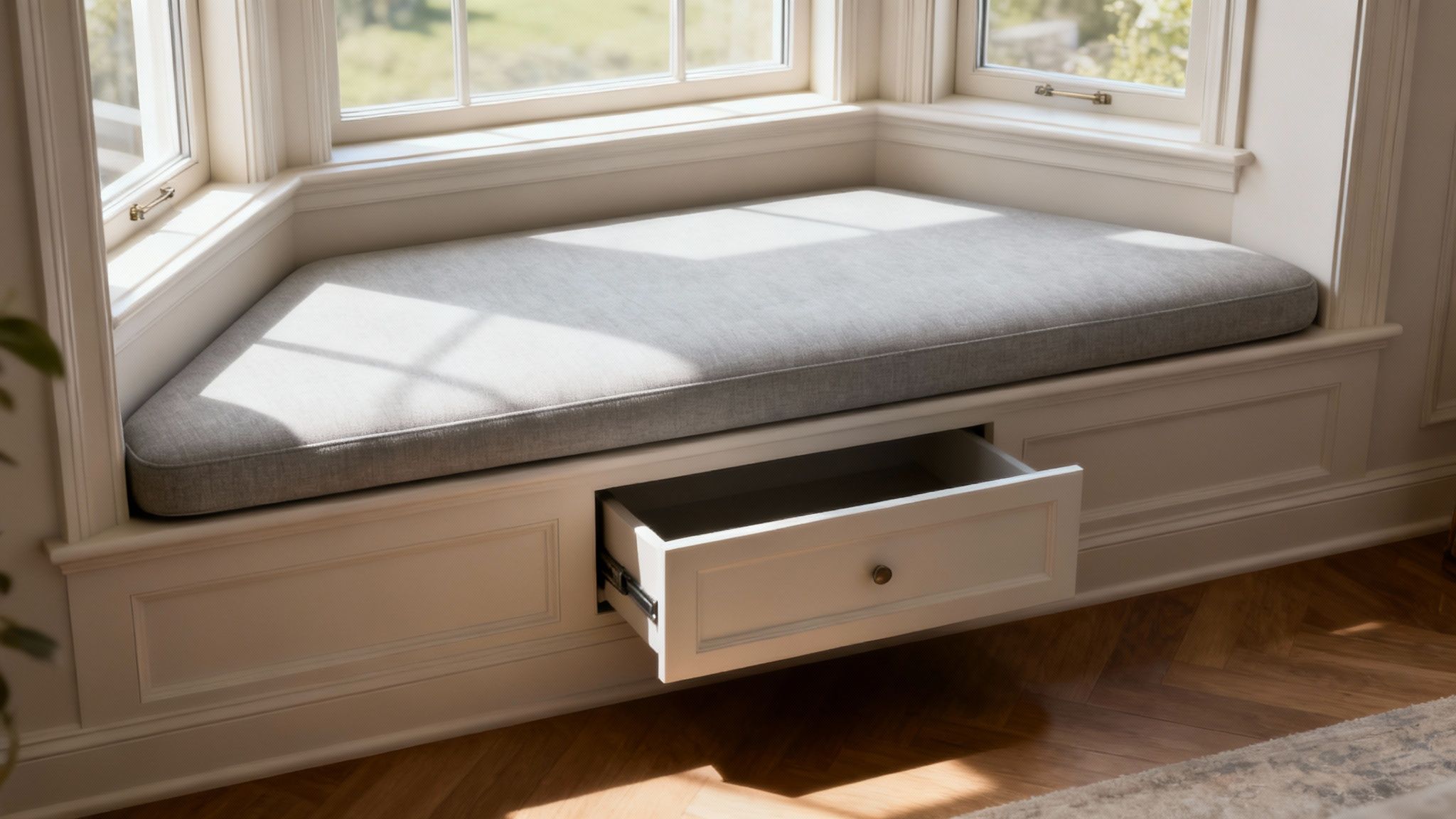
Planning for Comfort and Durability
With your measurements down, you can shift your focus to comfort. The depth of the seat is crucial here. I always suggest aiming for somewhere between 45 to 55 cm. This gives you plenty of room to sit back comfortably without feeling like you're perched on a narrow ledge. For height, a standard dining chair is a great benchmark – about 45 cm from the floor (including the cushion) is just about perfect.
Now, let's talk cushions. The foam you choose will make or break the comfort of your new nook. For a window seat that’s going to see a lot of use, high-density foam is a fantastic choice. It offers firm support and, crucially, keeps its shape over time. A medium-density foam can also work if you prefer a slightly softer feel, but I'd steer clear of low-density options as they tend to flatten out disappointingly quickly.
Fabric choice is all about durability. This is a high-traffic spot, especially in a busy family home. Always check the Martindale rub count, which is a measure of a fabric's resilience. You should be looking for something with a score of over 20,000. Tough upholstery fabrics like treated cottons, linens, or even a hard-wearing velvet are all excellent options that will stand the test of time.
Built-In Genius or Freestanding Flexibility?
You’ve got two main paths to follow here: a fully built-in seat or a more flexible freestanding bench. Each has its own merits.
Built-in Seats: These are custom-made to fit the exact contours of your bay. The result is a seamless, professional look that offers the perfect opportunity to sneak in some clever storage – a massive win in any home.
Freestanding Benches: A freestanding bench gives you more flexibility. You can easily move it if you decide to repurpose the space down the line, and it’s a less permanent change to the room. It’s a great way to test the waters if you're not quite ready to commit to a built-in project.
A built-in design is the ultimate way to maximise your space. Think beyond just a simple box; consider installing deep drawers for hiding away blankets and board games, or a hinged lift-up lid for stowing larger, seasonal items.
Integrating storage is one of the smartest things you can do. It turns a beautiful feature into a genuinely hard-working piece of furniture. To get your creative juices flowing, it’s worth exploring some clever storage ideas to build in while you renovate and see how integrated solutions can completely change a space.
Ultimately, a well-designed window seat does more than just fill an awkward corner. It creates a destination within a room – a cosy, light-filled nook that adds real value and personality to your home. By planning carefully and choosing materials that last, you can create a feature you’ll love for years to come.
More Than Just a Window Seat: Creative Styling Ideas
A built-in window seat is a lovely, classic choice, but it’s certainly not the only way to make a bay window the star of your room. If a permanent bench doesn't fit your space or how you live, don't worry. There are so many other brilliant ways to use that beautiful, light-filled alcove.
Thinking beyond the classic bench seat really opens up the possibilities. The unique angled shape of a bay window naturally creates a little 'zone' within a room, which is perfect for dedicating to a specific purpose or just showing off your personal style. It’s a fantastic opportunity to add another layer of character to your home.
The Sun-Drenched Home Office
One of my favourite ways to use a bay window is to turn it into a compact, inspiring workspace. All that natural light is a known mood-booster and helps with focus, making it a genuinely brilliant spot for a home office.
You don't need a huge, clunky setup, either. A slim, elegant desk that fits neatly into the central nook, paired with a comfortable and stylish chair, is often all it takes. This approach carves out a dedicated work-from-home spot without eating into your main living area, proving that even a small alcove can be incredibly practical.
Create a Lush Indoor Garden
If you're a plant lover, a bay window is the perfect stage for a show-stopping indoor jungle. The angled glass gives your plants the varied, all-day light they crave, turning the space into a vibrant, living feature that changes with the seasons.
- Play with height: I always suggest mixing it up. Use a tall floor plant like a Fiddle Leaf Fig to add drama, place medium-sized pots on plant stands, and let smaller trailing plants like Pothos or String of Pearls cascade from the windowsill.
- Group for impact: Don't just line them up! Clustering plants in odd numbers, like groups of three or five, with different leaf shapes and textures, creates a far more dynamic and professionally curated look.
- Choose pots with purpose: Your pots are part of the decor. Whether you opt for earthy terracotta, sleek ceramics, or rustic woven baskets, make sure they complement the style of your room.
A "plant bay" like this isn't just beautiful; it actively improves your home's air quality and brings a welcome sense of calm and nature indoors.
A Gallery for Your Favourite Things
Think of your bay window sill—or a low console table placed inside the nook—as your own personal gallery space. It’s the ideal spot to curate a display of your most treasured objects, turning the window into an artistic focal point that tells your story.
Your bay window can be a constantly evolving display. Unlike a fixed piece of furniture, a styled console or windowsill allows you to easily swap out objects with the seasons or as your tastes change, keeping the space feeling fresh and personal.
Arranging a collection of sculptural vases, propping a favourite piece of art against the glass, or adding a statement lamp can create a truly powerful visual moment. The principles are much the same as styling other display areas. In fact, learning how to style bookshelves can give you some great transferable skills for creating a balanced and beautiful arrangement in your bay. By treating it as a display area, you give the space a clear, elegant purpose that is uniquely you.
Making the Space Your Own with Lighting and Accessories

Now that the main pieces are in place, it’s time for the fun part. The right finishing touches will take your bay window from simply decorated to thoughtfully designed. Lighting and accessories are what breathe personality and warmth into a space, completing the picture and turning it into your new favourite corner.
Good lighting is absolutely essential. A bay window is already a natural focal point, so your lighting should play to that strength. I always advise thinking in layers to build a flexible, inviting atmosphere that’s just as good on a bright morning as it is on a cosy evening.
Lighting Up Your Nook
A single, beautiful pendant light hung in the centre of the bay can make a real statement. This is a brilliant trick if you have a window seat or a small table, as it draws the eye and anchors the whole zone. The style of the pendant itself can set the entire mood, whether it’s a sleek, modern piece or something more rustic and woven.
If you prefer a cleaner, more understated look, you could have recessed spotlights fitted into the ceiling above the bay. This gives fantastic ambient light without adding any visual clutter, letting the view or your curated objects take centre stage. An even simpler idea is to pop a stylish table lamp on a windowsill or a nearby side table. It’s perfect for adding a warm, localised glow for reading in the evenings.
The light bulb you choose is just as crucial as the fixture. A warm white bulb (around 2700K) gives off a relaxing, cosy light, whereas a cooler tone is more energising if you’re creating a workspace.
Getting the bulb right can genuinely transform the feel of a room. If you want to dive deeper, our guide to decorative light bulbs shows how they can be a design feature all on their own.
How to Accessorise Without the Clutter
Accessorising is a fine art—you're aiming for personality, not chaos. In a defined space like a bay window, every single item needs to earn its place.
- Go Green: Plants and light-filled bays are a match made in heaven. Mix up the scale with a large floor plant in one corner and maybe a little cluster of succulents on the sill.
- Layer Up with Textiles: Cushions and throws are your best friends here, especially for a window seat. They add colour, pattern, and pure comfort. I love mixing textures like velvet, linen, and chunky knits to create a richer, more inviting feel.
- Group for Impact: Rather than scattering small trinkets around, group them together. A trio of ceramic vases in varying heights or a stack of your favourite art books next to a small sculpture will look much more deliberate and curated.
By layering your lighting and choosing your accessories with care, your bay window will become a beautifully finished space that’s not just stylish, but truly yours.
Your Top Bay Window Questions, Answered
As you start to map out your bay window design, you’ll probably find a few questions cropping up. It's totally normal. From tackling those tricky angles to making the space feel like it belongs to the rest of the room, let's walk through some of the most common decorating hurdles.
Getting these final touches right is what elevates a nice feature into a truly stunning focal point.
How Can I Dress a Bay Window Without Curtains?
If traditional curtains feel a bit too heavy or fussy for your taste, don't worry—you've got plenty of sleek alternatives.
For a clean, modern aesthetic that still brings a touch of softness, Roman blinds are a brilliant choice. When they're down, they offer a lovely block of colour or pattern, and when you pull them up, they stack into these neat, elegant folds. They’re a really polished look.
Another fantastic option is Venetian blinds. These are the champions of light and privacy control. You can get them in classic wood for a warm feel or sleek aluminium for something more contemporary. They give each individual pane a really structured, tidy appearance. If you're looking for a top-tier, seamless finish, custom-fitted plantation shutters are a worthy investment. They feel less like a window dressing and more like part of the window's architecture, offering a timeless look that just works.
What's the Best Way to Add Storage?
Hands down, the most effective way to sneak in storage is with a custom-built window seat that has it integrated right in. Think deep drawers that pull out smoothly or a classic hinged lid that lifts up. This approach makes the storage feel completely intentional, almost architectural, and it's perfect for hiding away extra blankets, board games, or seasonal cushions.
If you're not ready for a permanent built-in, you can get a similar effect by placing a low, freestanding bench in the bay. Just slide a few stylish woven baskets or decorative boxes underneath. It gives you that much-needed space to keep things organised but with a more relaxed, flexible feel.
The real trick is to make your storage solution look like it was always meant to be there. Whether you go for a built-in or a bench with baskets, using materials and colours that echo other elements in the room will create a seamless, cohesive design.
Should My Bay Window Decor Match the Rest of the Room?
The goal here is to complement, not necessarily to match perfectly. It helps to think of your bay window as its own little 'zone'—a cosy nook that has its own personality but still feels connected to the main room. This gives you the freedom to be a bit more creative without clashing with your overall scheme.
So, how do you create that connection? Pull an accent colour from a piece of art or your sofa and use it for the cushions on your window seat. Or, choose a fabric for your Roman blinds that coordinates with the main curtains. The key is to maintain a consistent colour palette and use similar finishes—like matching the wood tone of a bench to your coffee table, for example. This is what makes the entire space feel thoughtfully and beautifully pulled together.

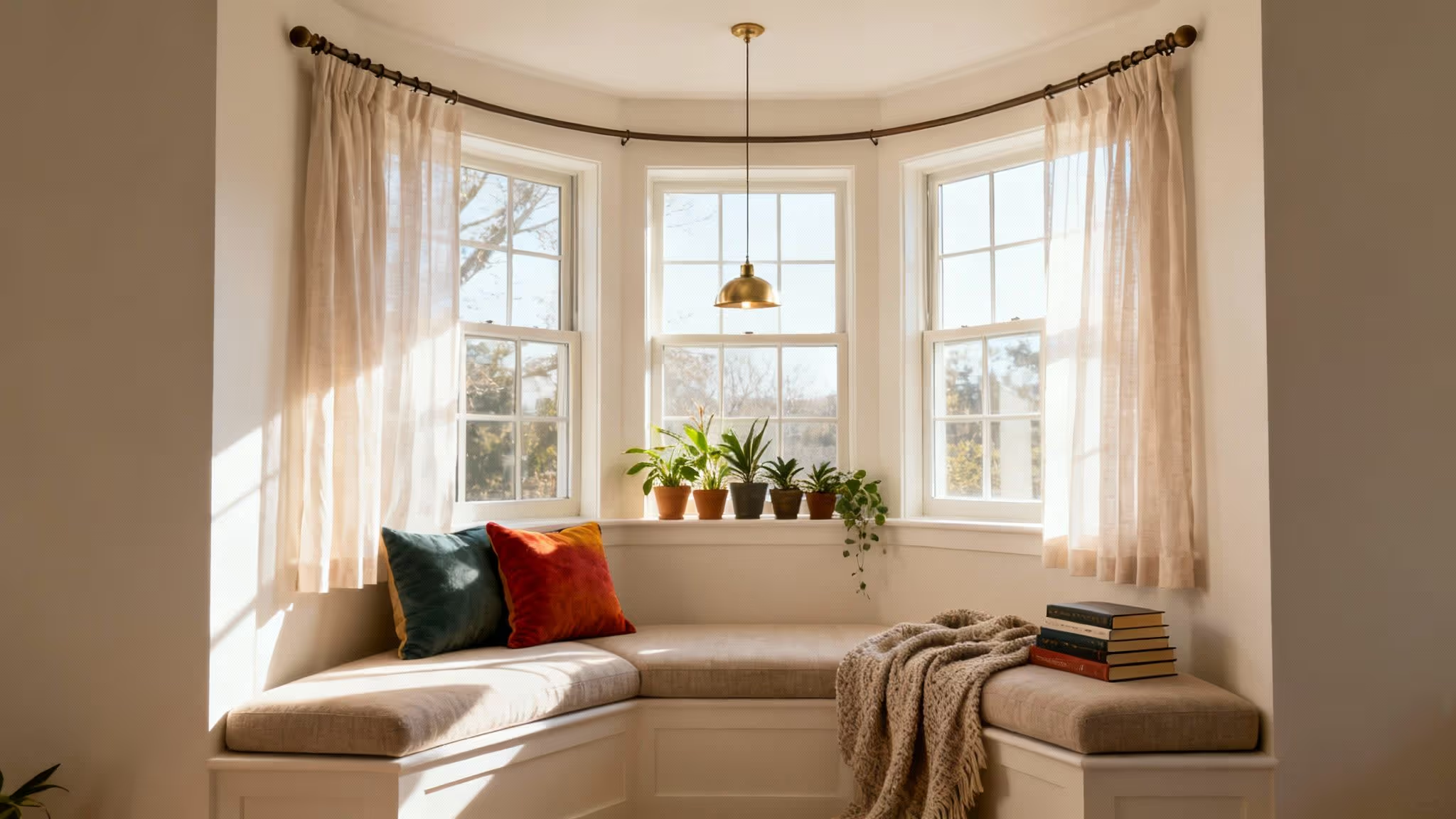
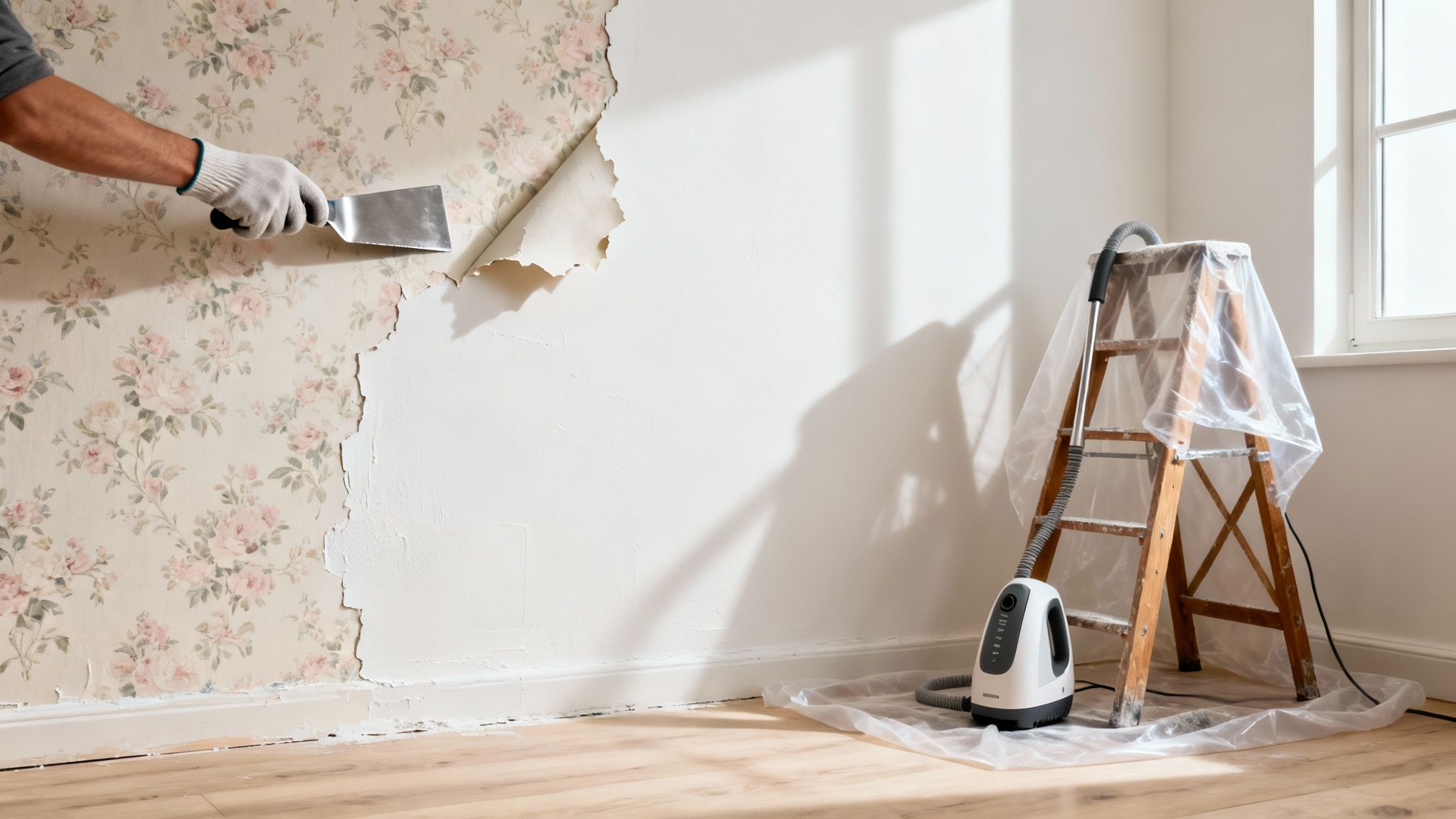
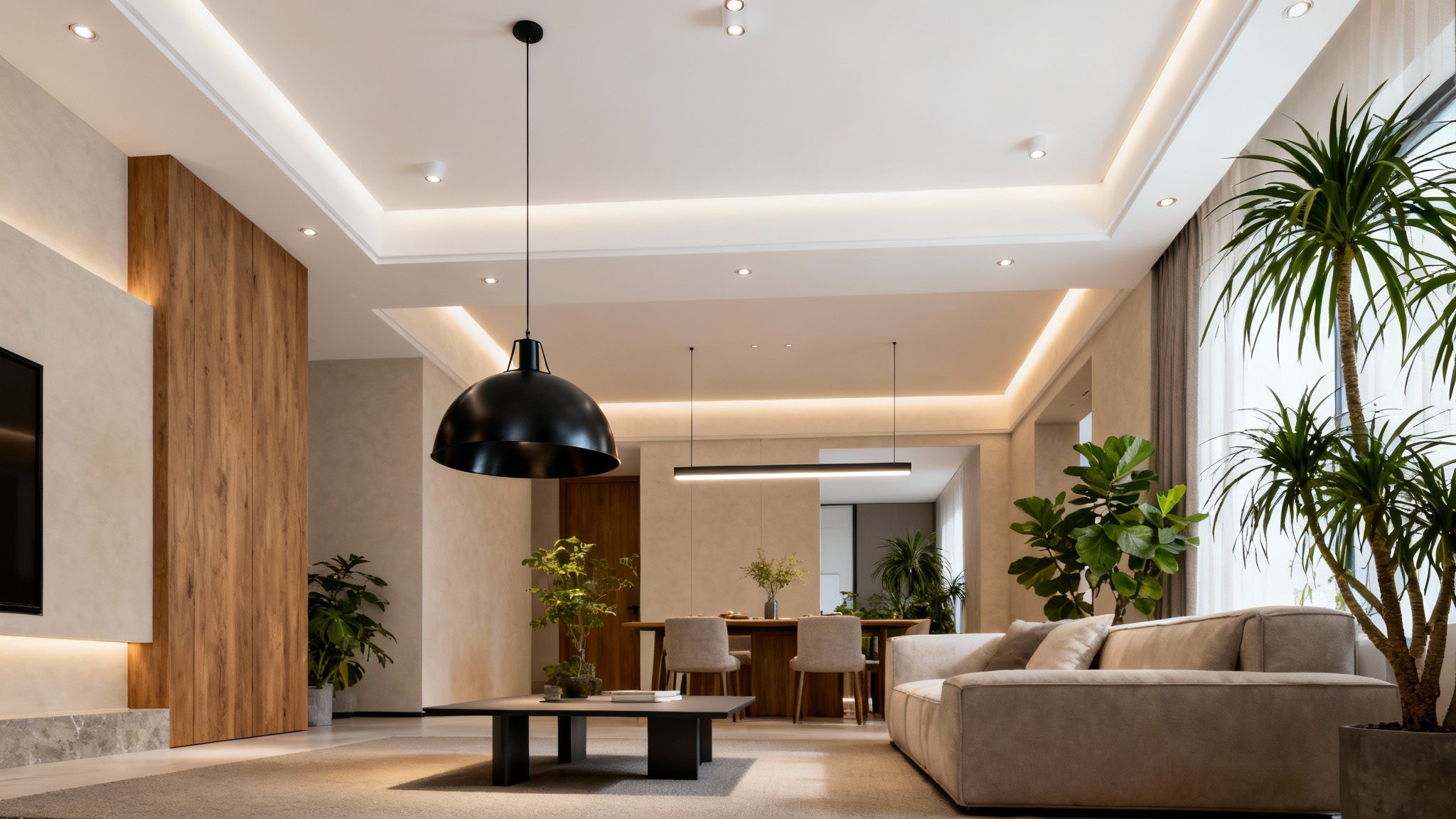
.jpeg)